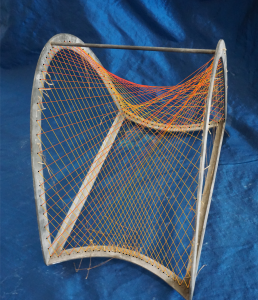History of the Models
The creation of models such as ours began in the late 19th century, alongside revolutions in algebraic geometry and differential geometry. Many new mathematical objects were discovered in the late 19th century, so mathematicians began building models to demonstrate their properties. At the time, such models depicted objects at the forefront of research on algebraic surfaces. The earliest record of model building dates back to 1873 and deals with a plaster model of Steiner's Roman surface built by German mathematician Ernst Kummer.
Many mathematicians took interest in model building. German mathematicians Alexander von Brill and Felix Klein were particularly active in designing and building them, as were several of Klein's students. Other notable mathematicians involved included Plücker, Schwarz, Hilbert, Darboux, and Grassmann. Plücker's collection included many beautiful wooden models - see the London Mathematical Society's page.
The German company L. Brill, taken over by M. Schilling in 1899, produced a vast range of models over a period of around 50 years. The models were distributed to universities across Europe and America, often for the purpose of teaching, as well as for their aesthetic appeal. Production began in the 1870s, and peaked around the 1910s. An impressive Schilling catalogue from 1911 features almost 400 works from 40 series of models. Our site lists models as they are found in this catalogue: for example "Model VII 1" refers to the 1st model in the seventh series of models.
The models commanded impressive prices, with some costing more than the equivalent of £250 today. Interest in them petered out during the First World War, and after financial difficulties Schilling ceased production. In any case the increasingly austere writing style of the time, such as that of the influential Bourbaki group, steered written mathematics away from over-use of diagrams and examples [1]. Moreover, increasing abstraction and generalisation in mathematics meant that objects of research could not be conveyed well with 3D models.
The models have a timeless appeal, and despite the decline in their use they have always retained a following. Gerd Fischer gave an excellent account of some models [2,3] in 1986, and Irene Polo-Blanco wrote an extensive thesis [4] on the theory and history of the models in 2007. For a list of other universities with similar collections of models, including links to their websites where applicable, see Other Collections. There are many interesting accounts of the history of the models, some of which are listed amongst this page's references [6-15].
There is growing interest in the restoration/recreation of models, such as Cayetano Ramírez López's work on recreating a plaster model of the Clebsch diagonal surface, and the creation of polyester models [5]. Indeed, you can now buy a large range of 3-D printed models, including many featured on these pages, from math-sculpture.com via their Shapeways store. As well as the plaster models, we have a number of string models of ruled surfaces, currently in a poor state because the original silk has perished. There is scope for restringing some models, in order to restore their original beauty. Here is a digital restringing of a hyperbolic paraboloid.

References
[1] Leo Corry, Writing the Ultimate Mathematical Textbook: Nicolas Bourbaki’s Éléments de mathématique, www.tau.ac.il/~corry/publications/articles/pdf/Bourbaki%20-%20OHHM.pdf
[2] Gerd Fischer. Mathematical Models. Vieweg & Sohn, first edition, 1986.
[3] Gerd Fischer. Mathematical Models, Commentary. Vieweg & Sohn, first edition, 1986.
[4] I. Polo-Blanco, Theory and history of geometric models (2007) s.n. https://www.rug.nl/research/portal/files/2803507/thesis.pdf
[5] Sergio Hernández et. al, Models of cubic surfaces in polyester, http://archive.bridgesmathart.org/2006/bridges2006-309.pdf
[5] William Mueller, Mathematical Wunderkammern (2001), wmueller.com/home/papers/wund.pdf
[6] Jeremy J. Gray, Years ago (1995), link.springer.com/article/10.1007/BF03024791
[7] University of Illinois, Mathematics Model Collection History, http://www.math.illinois.edu/History/mathmodels-calendartops.pdf
[8] Angela Vierling-Claassen, Models of Surfaces and Abstract Art in the Early 20th Century, http://archive.bridgesmathart.org/2010/bridges2010-11.pdf
[9] Philip Ording, Mathematical Objects, http://science.slc.edu/~pording/MathObjectsCabinet.pdf
[10] W. Mueller, Lost Geometry, http://wmueller.com/home/papers/lost.html
[11] David E. Rowe, Mathematical models as artefacts for research: Felix Klein and the case of Kummer surfaces, http://link.springer.com/article/10.1007%2Fs00591-013-0119-8
[12] Angela Vierling-Claassen, The "Botanical" Study of Algebraic Surfaces in the 19th Century, http://www.researchgate.net/publication/2356883_The_Botanical_Study_of_…
[13] Herbert Mehrtens, '"Mathematical Models", Models: The Third Dimension of Science (eds. S de Chadarevian, N Hopwood), Stanford University Press (2004), pp. 276-306.
[14] Francois Apéry, OLD AND NEW MATHEMATICAL MODELS: SAVING THE HERITAGE OF THE INSTITUT HENRI POINCARÉ, http://www.math-art.eu/Documents/pdfs/Ap%C3%A9ry.pdf
[15] LIVIA GIACARDI, MODELS IN MATHEMATICS TEACHING IN ITALY (1850-1950), http://www.math-art.eu/Documents/pdfs/Cagliari2013/MODELS%20IN%20MATHEM…

